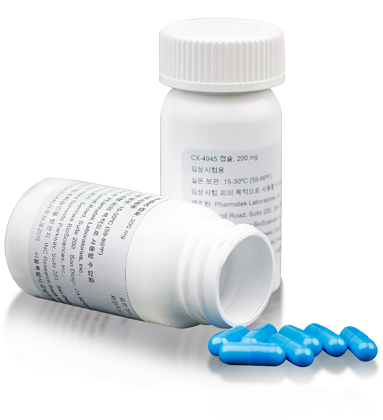- Silmitasertib
- CX-4945
- Casein Kinase 2 (inhibitor)
- Silmitasertib (CX-4945), a synthetically derived small molecule, is provided as sodium salt in hard gelatin capsule shells with oral administration.


CK2 (Casein kinase 2) is a protein kinase that has elevated activity in many cancers and has a direct role in DNA damage repair. The DNA repair pathways enable tumor cells to survive damage induced by treatment with chemotherapeutic agents. Inhibitors of DNA repair pathways have been shown to increase the efficacy of DNA-damaging chemotherapeutic drugs when these are used in combination.
Silmitasertib is a first-in-class potent and highly selective inhibitor for CK2. It has demonstrated favorable safety, pharmacokinetic (PK) characteristics and pharmacodynamics (PD) responses in clinical studies.
Clinical observations show that Silmitasertib hits the CK2 target and modulates the expected pathways without displaying toxicity. Silmitasertib achieved clinical benefit as a single agent CK2 inhibitor. A combination of Silmitasertib with the DNA damaging agents such as gemcitabine (Gemzar) plus cisplatin (Platinol), has been shown to act synergistically to improve the efficacy of these anticancer treatments.
Silmitasetib interacts competitively with the ATP-binding site of CK2 subunit alpha, leading towards the inhibition of several downstream signaling pathways:
Silmitasertib demonstrated anti-viral and anti-inflammatory efficacy in COVID-19 in vitro studies. As it targets host protein kinase CK2, SARS-CoV-2 virus mutations are unlikely to affect Silmitasertib anti-viral efficacy.
Please find more details of Silmitasertib's dual MOA (Mechanism of Action) and developments in the attached file, below.
Details of Silmitasertib’s dual MOA (Mechanism of Action) and Developments